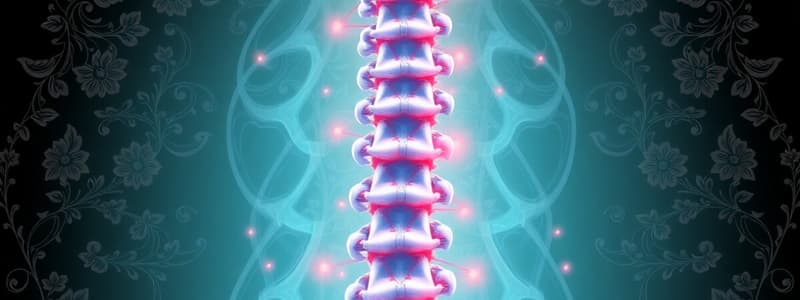Podcast
Questions and Answers
What structure in the lumbar region primarily contributes to central lumbar stenosis?
What structure in the lumbar region primarily contributes to central lumbar stenosis?
- Overgrowth of facet joints (correct)
- Compression from surrounding muscles
- Neural foramina enlargement
- Herniated disc
Which of the following correctly describes the impact of central lumbar stenosis on neurological function?
Which of the following correctly describes the impact of central lumbar stenosis on neurological function?
- It leads to unilateral neural compromise.
- It does not cause any significant neurological symptoms.
- It only affects motor functions.
- All dermatomes and myotomes below the affected area are compromised. (correct)
Which condition is a result of abnormal motion in the lumbar spine associated with central lumbar stenosis?
Which condition is a result of abnormal motion in the lumbar spine associated with central lumbar stenosis?
- Herniated disc
- Cervical radiculopathy
- Spondylolisthesis (correct)
- Sciatica
What is a result of ligamentum flavum hypertrophy in the context of lumbar spinal issues?
What is a result of ligamentum flavum hypertrophy in the context of lumbar spinal issues?
What type of stenosis occurs bilaterally in the context of central lumbar issues?
What type of stenosis occurs bilaterally in the context of central lumbar issues?
Flashcards
Central Lumbar Stenosis
Central Lumbar Stenosis
A condition where the spinal canal in the lower back (lumbar region) narrows, putting pressure on the spinal cord.
Ligament Overgrowth in Central Lumbar Stenosis
Ligament Overgrowth in Central Lumbar Stenosis
The ligaments in the back can thicken and harden, putting pressure on the spinal cord.
Facet Joint Overgrowth in Central Lumbar Stenosis
Facet Joint Overgrowth in Central Lumbar Stenosis
The facet joints, located in the back of the spine, can develop bony growths, also putting pressure on the spinal cord.
Calcification of Ligaments in Central Lumbar Stenosis
Calcification of Ligaments in Central Lumbar Stenosis
Signup and view all the flashcards
Spondylolisthesis in Central Lumbar Stenosis
Spondylolisthesis in Central Lumbar Stenosis
Signup and view all the flashcards
Study Notes
Central Lumbar Stenosis
- Narrowing of the lumbar spinal column.
- Compression of the spinal cord.
- Ligaments originating from the back contribute to the compression.
- Compression also occurs from lateral aspects.
- Overgrowth on facet joints and calcification of ligaments contribute to the spinal narrowing.
- Condition is often bilateral (affects both sides).
- All sensory (dermatomes) and motor (myotomes) functions below the affected level are likely affected.
Causes of Spinal Compression
- Abnormal spinal movement (spondylolisthesis). Spondylolisthesis can be either anterior (ante) or posterior (retro).
- Compression at specific vertebral levels (e.g., C3-4, C4-5, though the context refers to lumbar stenosis)
- Thickening of the ligamentum flavum (posterior spinal canal compromise).
Studying That Suits You
Use AI to generate personalized quizzes and flashcards to suit your learning preferences.





